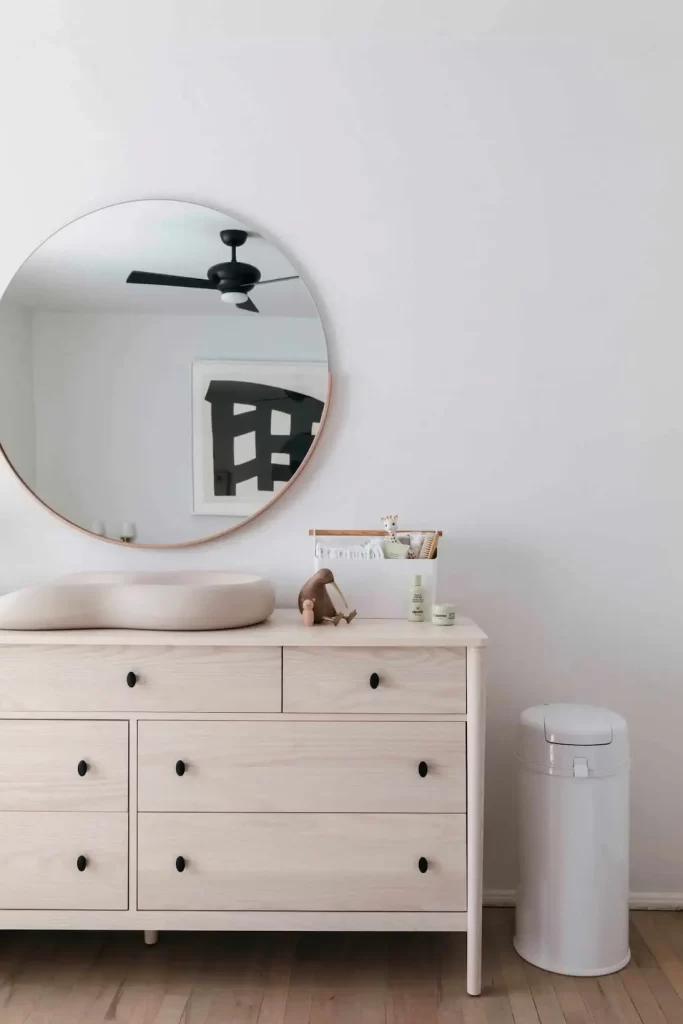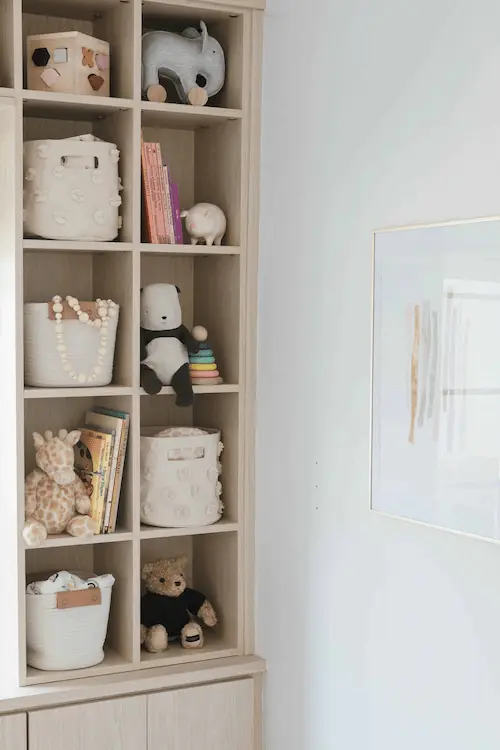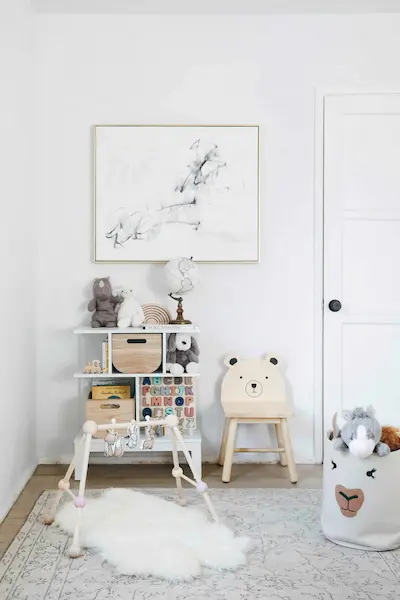How to Make Room For a Baby When You Don’t Have Space For a Nursery

Introduction on how to decorate for a baby without having a nursery
Preparing for a baby can feel like a monumental task, especially when creating a space for your new bundle of joy.
The common conception is that you need a dedicated nursery, but what if you don’t have an extra room to spare?
Don’t worry—you’re not alone. Many parents face this challenge and have found ingenious solutions.
This comprehensive guide on how to decorate for a baby without having a nursery will provide you with practical tips, creative nursery ideas, and effective strategies to create a comfortable, functional, and beautiful space for your baby, even within the confines of limited square footage.
Understanding space constraints
The reality of limited space
In urban environments or homes with limited square footage, having an extra room to dedicate to a nursery can be a luxury.
Small spaces, however, don’t necessarily mean compromising on comfort or functionality.
They foster creativity and resourcefulness, creating cozy, efficient, and unique spaces.
Benefits of a non-traditional Nursery
While a traditional nursery has advantages, there’s much to say about non-traditional baby spaces. Firstly, they promote closeness and bonding, as the baby is always near the parents.
Secondly, they can be more budget-friendly, often requiring fewer furnishings and decorations.
Lastly, they encourage minimalist living and thoughtful consumption, as parents must carefully consider each purchase for space efficiency and practicality.
Getting started
Assessing your space
Before you start decorating, take a good look at your available space. Is there an unused corner in your bedroom? Could the living room accommodate a play area? Could the dining room double as a changing station?
You can uncover surprising opportunities for creating a baby-friendly environment by looking at your space with fresh eyes.
Purging unnecessary items
Less is more when decorating for a baby in a small space. Start by decluttering and removing items you don’t need or use regularly.
This frees up space for baby essentials and reduces the cleaning and organizing you’ll need to do once the baby arrives.
Making a plan
With a clear idea of your available space, you can now start planning your baby area.
Make a list of essential items, like a crib or bassinet, a changing station, and storage for baby clothes and supplies.
Remember that many baby items come in compact or foldable versions, perfect for small spaces.
Essential baby items
Cribs and sleeping arrangements

You’ll first need a place for your baby to sleep. Mini cribs, co-sleepers, and bassinets are all great options for small spaces.
Some of these can even be attached to your own bed, making nighttime feedings and diaper changes easier.
Changing stations

A changing station is another essential item. A fold-down changing table or a changing pad that can be stowed away when not in use can save a lot of space.
Alternatively, a changing pad on top of an existing dresser can double as a changing station without taking up additional room.
Storage solutions

Babies may be small, but they come with a lot of stuff. Clothes, diapers, toys, feeding supplies—the list goes on. Clever storage solutions are key.
Consider using under-bed storage, over-the-door organizers, and wall-mounted shelves to store all your baby’s belongings without cluttering your space.
Creative decorating ideas
Using walls and vertical space

When floor space is at a premium, it’s time to think vertically. Shelves, wall-mounted cabinets, and hanging organizers can provide ample storage without taking up floor space.
Wall decals or murals can also serve as beautiful, baby-friendly nursery decor.
Multi-functional furniture
Nursery furniture that serves multiple purposes can be a game-changer in a small space.
Consider a crib with built-in drawers, a changing table that doubles as a dresser, or a rocking chair that can feed and comfort the baby.
Color schemes and themes
Just because you’re not creating a traditional nursery design doesn’t mean you can’t have a theme or color scheme. Choose colors that are calming and complement the rest of your decor.
A themed accent wall mural or matching crib bedding and curtains can tie the baby area together and make it feel special.
Safety considerations
Safe sleeping practices
Safety should be your top priority regardless of where you set up your baby’s sleeping area.
Ensure the crib or bassinet meets safety standards, and avoid overcrowding it with toys or blankets.
The area around the baby’s sleeping spot should also be free of small objects or loose cords that could pose a hazard.
Baby-proofing your space
Baby-proofing will become crucial as your little one starts to move around. Secure furniture to the walls to prevent tipping, cover outlets, and keep small or sharp objects out of reach.
Remember, what’s low to the ground is prime real estate for a baby, so floor-level cabinets and shelves should be secured or emptied of non-baby items.
Making room for play
Creative play areas

Just because you’re short on space doesn’t mean your baby can’t have a dedicated play area. Look for unused corners or spaces under tables that can be transformed into a play area with a soft rug and a few toys.
Consider a wall-mounted activity board or a foldable play mat that can be stowed away when unused.
Keeping toys organized
A place for everything and everything in its place is a good motto to live by when decorating for a baby in a small space. Use baskets, bins, or a small bookcase to keep toys organized.
Remember to rotate toys regularly to keep your baby’s interest while minimizing the need for excess storage.
Incorporating baby items into existing decor
Seamless integration
One way to decorate for a baby without a nursery is to integrate baby items into your existing decor seamlessly. Choose baby items that match your color scheme and style.
A stylish high chair can blend into your dining room, a sleek mini crib complement your bedroom, and beautiful storage baskets enhance your living room while holding baby essentials.
Maintaining adult aesthetics

While creating a baby-friendly space is important, your home should also reflect your adult aesthetics. Maintain areas that are just for adults, even if they’re small.
This could be a cozy reading corner, a stylish coffee table display, or a beautiful piece of artwork. This way, your home remains a sanctuary for you, even as it adapts to accommodate your new arrival.
Making the most of shared spaces
Sharing a room with baby
Sharing a room with your baby can be a wonderful experience. It allows for easy nighttime feedings and lets you closely monitor your little one.
Consider using a room divider or a canopy to delineate the baby’s space to make it work. This will provide a sense of separation while allowing you to stay close.
Living room as a nursery
The living room can double as a nursery if a shared bedroom isn’t an option. A corner of the room can be dedicated to a mini crib and a small changing station.
Toys can be stored in a stylish bin or basket that blends with your decor. Just be sure to baby-proof the area thoroughly to keep your little one safe.
Dealing with challenges
Coping with noise and light
One challenge of having a baby in a shared space is dealing with noise and light that could disrupt the baby’s sleep. Blackout curtains or blinds can help manage light levels, while a white noise machine can mask disruptive noises.
A small lamp or dimmable light for nighttime feedings or diaper changes is also a good idea.
Maintaining privacy
Maintaining privacy can be another challenge when sharing your space with a baby. Room dividers, screens, or curtains can provide some privacy.
Also, consider using baby monitors to keep an eye on your baby while you’re enjoying some alone time in another part of the house.
Growth and adaptation
Planning for baby’s growth
As your baby grows, their needs and interests will change, and your space will need to adapt accordingly. What works for a newborn may not work for a crawling baby or a curious toddler.
Anticipate these changes and plan for flexible solutions. An open floor space can become a play area, a drawer can be repurposed for toy storage, or a wall can be decorated with educational posters.
Adapting decor over time
Your decor should also evolve as your baby grows. The pastel color scheme that was perfect for your newborn might be replaced with brighter colors as your baby grows into a toddler.
Nursery themes and decorations can be changed to reflect your child’s developing interests. Remember, your space is not static but a dynamic environment that grows with your child.
Conclusion on how to decorate for a baby without having a nursery
Decorating for a baby without having a nursery can be a creative and rewarding experience. It involves making the most of your available space, selecting multi-functional furniture, and ensuring safety at all times.
Remember, the goal is to create a comfortable, functional, and beautiful space for your baby while maintaining your adult aesthetics.
With thoughtful planning and creativity, you can create a wonderful, baby-friendly space, no nursery required!
Also Read:
- How to Decorate a Newborn Nursery On a Budget
- Create a Magical Dumbo Nursery for Your Baby Girl
- How to Organize a Baby Dresser
- How to Make Bumper Pads for Baby Crib
FAQs on how to decorate for a baby without having a nursery
How can I make a small space baby-friendly?
Start by decluttering and making room for essential baby items. Use multifunctional furniture and maximize vertical space.
Ensure the space is safe and baby-proofed. Finally, create a space that can adapt and grow with your baby.
Can a baby sleep in the parents’ room?
Absolutely. The American Academy of Pediatrics recommends that babies sleep in the same room as their parents for at least the first six months for safety reasons.
How can I maintain my adult aesthetics while decorating for a baby?
Choose baby items that complement your existing decor and color scheme. Maintain small areas that are just for adults.
And remember, not every inch of your home needs to scream “baby.”
What is the most important consideration when setting up a baby’s space?
Safety is the most crucial factor. Ensure the sleeping area meets safety standards, secure furniture to prevent tipping, cover outlets, and keep small or sharp objects out of reach.
Can the living room double as a nursery?
Yes, a living room corner can be dedicated to a mini crib and a small changing station. Be sure to baby-proof the area thoroughly.
How can I deal with noise and light in a shared space?
Blackout curtains or blinds can help manage light levels, while a white noise machine can mask disruptive noises.
A small lamp or a dimmable light is also useful for nighttime feedings or diaper changes.
